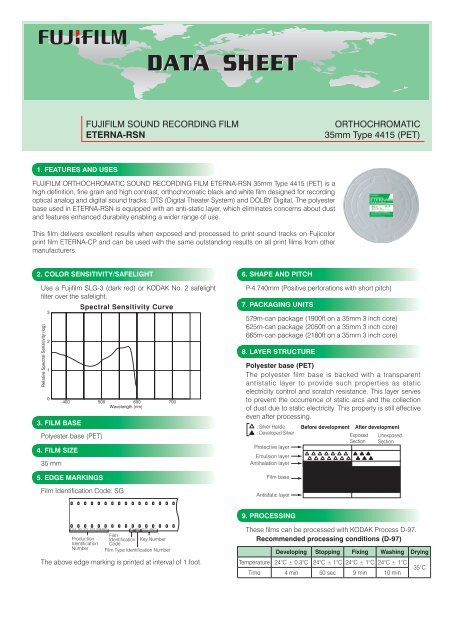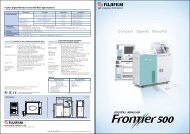FUJIFILM SOUND RECORDING FILM ORTHOCHROMATIC ...
FUJIFILM SOUND RECORDING FILM ORTHOCHROMATIC ...
FUJIFILM SOUND RECORDING FILM ORTHOCHROMATIC ...
You also want an ePaper? Increase the reach of your titles
YUMPU automatically turns print PDFs into web optimized ePapers that Google loves.
1. FEATURES AND USES<br />
<strong>FUJI<strong>FILM</strong></strong> <strong>ORTHOCHROMATIC</strong> <strong>SOUND</strong> <strong>RECORDING</strong> <strong>FILM</strong> ETERNA-RSN 35mm Type 4415 (PET) is a<br />
high definition, fine grain and high contrast, orthochromatic black and white film designed for recording<br />
optical analog and digital sound tracks: DTS (Digital Theater System) and DOLBY Digital. The polyester<br />
base used in ETERNA-RSN is equipped with an anti-static layer, which eliminates concerns about dust<br />
and features enhanced durability enabling a wider range of use.<br />
This film delivers excellent results when exposed and processed to print sound tracks on Fujicolor<br />
print film ETERNA-CP and can be used with the same outstanding results on all print films from other<br />
manufacturers.<br />
2. COLOR SENSITIVITY/SAFELIGHT<br />
Use a Fujifilm SLG-3 (dark red) or kODAk No. 2 safelight<br />
filter over the safelight.<br />
Spectral Sensitivity Curve<br />
Relative Spectral Sensitivity (log)<br />
3<br />
2<br />
1<br />
0<br />
400<br />
3. <strong>FILM</strong> BASE<br />
Polyester base (PET)<br />
4. <strong>FILM</strong> SIZE<br />
35 mm<br />
5. EDGE MARKINGS<br />
500 600<br />
Wavelength (nm)<br />
Film Identification Code: SG<br />
<strong>FUJI<strong>FILM</strong></strong> <strong>SOUND</strong> <strong>RECORDING</strong> <strong>FILM</strong> <strong>ORTHOCHROMATIC</strong><br />
ETERNA-RSN 35mm Type 4415 (PET)<br />
FUJI SG 321 010 098AB0 FS SG 0123 4567<br />
Production<br />
Identification<br />
Number<br />
Film<br />
Identification Key Number<br />
Code<br />
Film Type Identification Number<br />
The above edge marking is printed at interval of 1 foot.<br />
700<br />
6. SHAPE AND PITCH<br />
P-4.740mm (Positive perforations with short pitch)<br />
7. PACKAGING UNITS<br />
579m-can package (1900ft on a 35mm 3 inch core)<br />
625m-can package (2050ft on a 35mm 3 inch core)<br />
665m-can package (2180ft on a 35mm 3 inch core)<br />
8. LAYER STRUCTURE<br />
Polyester base (PET)<br />
The polyester film base is backed with a transparent<br />
antistatic layer to provide such properties as static<br />
electricity control and scratch resistance. This layer serves<br />
to prevent the occurrence of static arcs and the collection<br />
of dust due to static electricity. This property is still effective<br />
even after processing.<br />
: Silver Halide<br />
: Developed Silver<br />
Protective layer<br />
Emulsion layer<br />
Antihalation layer<br />
Film base<br />
Antistatic layer<br />
9. PROCESSING<br />
Before development After development<br />
Exposed<br />
Section<br />
Unexposed<br />
Section<br />
These films can be processed with kODAk Process D-97.<br />
Recommended processing conditions (D-97)<br />
Developing Stopping Fixing Washing Drying<br />
Temperature 24°C ± 0.3°C 24°C ± 1°C 24°C ± 1°C 24°C ± 1°C 35°C<br />
Time 4 min 50 sec 9 min 10 min
10. SHARPNESS (CTF) AND CHARACTERISTIC CURVE<br />
Response<br />
1<br />
0.1<br />
Contrast Transfer Function (CTF)<br />
0.01<br />
1 10 100<br />
Spatial frequency (cycles/mm)<br />
Processing: Kodak D97, 4min, 24°C Visual diffuse density<br />
Spatial frequency attenuation characteristic or amplitude<br />
relative to rectangular wave chart.<br />
(It should be noted, however, that the data presented was<br />
normalized with the amplitude of zero frequency.)<br />
11. HANDLING AND STORAGE OF <strong>FILM</strong><br />
• Store unexposed film at a temperature of 13°C (55°F) or less.<br />
• Film that has been stored at low temperature should be allowed to return to room temperature before opening. If you open film<br />
while it is still cold, condensation may form, the film surface may become more susceptible to damage, or winding slack may<br />
arise in the camera.<br />
• After exposing the film, you should process it as soon as possible.<br />
12. HANDLING AND STORAGE OF PROCESSED <strong>FILM</strong><br />
• To maximize image permanence, this film uses materials that exhibit as little compositional change as possible; however, it is<br />
not possible to completely eliminate the influence of light, heat, atmospheric ozone, gas pollutants, moisture, mold and other<br />
factors that affect image permanence. Controlling temperature and humidity is the most important factor in the preservation<br />
of film. For storage in a dark place for about 10 years, the film should be kept at a temperature of 25°C or lower, with humidity<br />
at 30% to 50%. In the case of storage for 20 years or more, the film should be kept at a temperature of 10°C or lower, with<br />
humidity at 30% to 50%.<br />
• Use of a desiccant is recommended during long-term film storage.<br />
Note : Data contained in the information above are the results of normal testing conducted by Fujifilm. Because of product<br />
improvements, film characteristics are subject to change without notice.<br />
Density<br />
5<br />
4<br />
3<br />
2<br />
1<br />
0<br />
-2.00<br />
Characteristic Curve<br />
Ref. No. FXX-KB-1104E (SK.11.08.F1079) Printed in Japan © 2011 <strong>FUJI<strong>FILM</strong></strong> Corporation<br />
-1.00<br />
0.00 1.00<br />
log E<br />
Processing:Kodak D97, 4min, 24˚C<br />
Measurement: Visual diffuse density<br />
Exposure Time: 100 microseconds<br />
2.00





